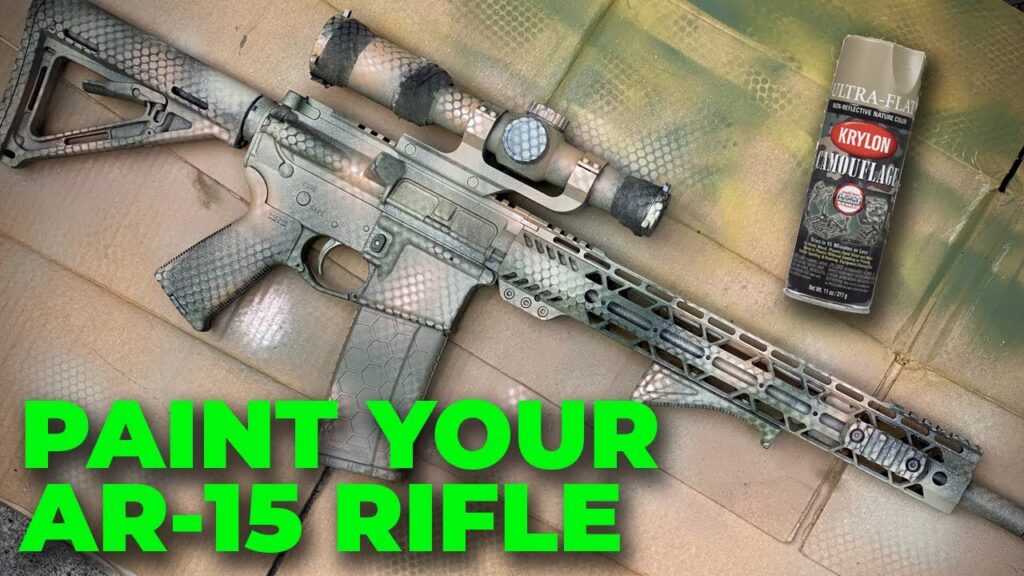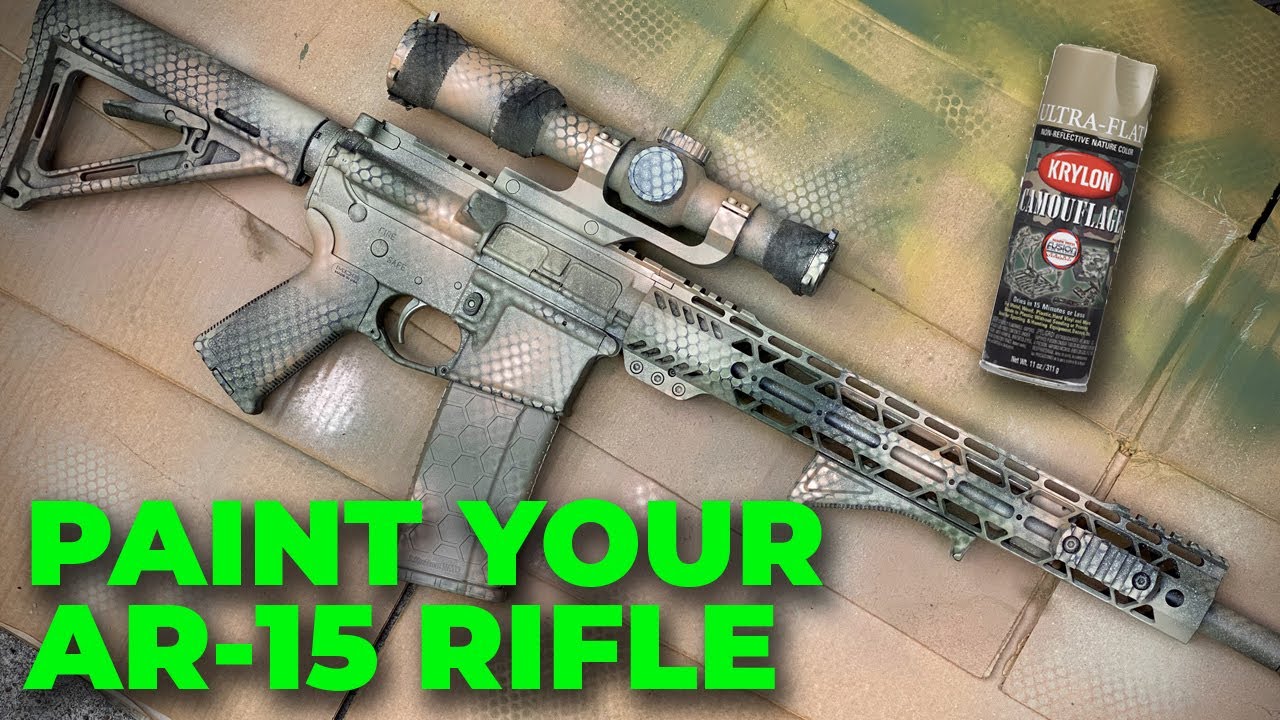
The Art and Science of the Painted Rifle: Customization, Camouflage, and Performance
The painted rifle has evolved from a purely aesthetic modification to a crucial element in tactical operations and competitive shooting. Beyond mere visual appeal, a well-executed painted rifle can significantly enhance camouflage, protect the firearm from the elements, and even improve grip. This article delves into the art and science behind painted rifles, exploring the various techniques, materials, and considerations involved in creating a functional and visually striking firearm.
The Evolution of Rifle Painting
The practice of painting rifles dates back to military conflicts where soldiers sought to blend their weapons with the surrounding environment. Early methods were rudimentary, often involving mud, foliage, or basic spray paints. However, as technology advanced, so did the techniques and materials used for painted rifles. Today, specialized coatings, stencils, and application methods allow for intricate camouflage patterns and durable finishes.
Historical Context
Historically, the need for concealment drove the initial adoption of painted rifles. Soldiers in World War II and subsequent conflicts recognized the advantage of disguising their weapons, reducing their visibility to the enemy. These early efforts were often improvised, reflecting the immediate needs of the battlefield. [See also: History of Camouflage Techniques]
Modern Applications
In contemporary military and law enforcement, painted rifles are standard practice. Snipers and reconnaissance teams rely on advanced camouflage patterns to remain undetected. Civilian shooters, including hunters and competitive marksmen, also embrace painted rifles for both practical and aesthetic reasons. The rise of DIY culture and readily available tutorials have further fueled the popularity of customizing firearms with paint.
Techniques for Painting Rifles
Several techniques can be used to achieve a professional-looking painted rifle. Each method offers varying degrees of complexity, durability, and visual appeal. Choosing the right technique depends on the desired outcome, available resources, and skill level.
Spray Painting
Spray painting is the most common and accessible method for painting rifles. It involves applying multiple layers of paint using aerosol cans or spray guns. Proper preparation, including cleaning and masking, is crucial for achieving a smooth and even finish. Stencils can be used to create intricate camouflage patterns. This method is versatile and allows for a wide range of colors and designs. The quality of the paint used significantly impacts the durability and longevity of the finish. [See also: Best Spray Paints for Firearms]
Cerakote
Cerakote is a ceramic-based finish applied through a specialized process that involves sandblasting and baking. It offers exceptional durability, corrosion resistance, and abrasion resistance. Cerakote is significantly more durable than traditional spray paint, making it ideal for firearms that will be subjected to harsh conditions. However, applying Cerakote requires specialized equipment and training, making it a more expensive option. Many professional gunsmiths offer Cerakote services, ensuring a high-quality finish. The process involves several stages, including surface preparation, application of the Cerakote, and curing in a specialized oven. The result is a hard, durable finish that can withstand extreme temperatures and environmental conditions.
Hydro Dipping
Hydro dipping, also known as immersion printing, involves transferring a pre-printed design onto the rifle’s surface using water displacement. The process involves floating a thin film of the desired pattern on water, then dipping the rifle into the water, allowing the pattern to adhere to the surface. Hydro dipping offers a wide range of patterns, including realistic camouflage designs and custom graphics. While relatively easy to perform, hydro dipping requires careful preparation and a clear topcoat to protect the design. The durability of hydro-dipped finishes can vary depending on the quality of the film and the topcoat applied. [See also: Hydro Dipping vs. Cerakote: A Comparison]
Materials and Tools Required
Successful painted rifle projects require the right materials and tools. Investing in quality products and equipment will significantly improve the final result and ensure a durable and long-lasting finish.
- Degreaser: Essential for removing oil, grease, and contaminants from the rifle’s surface.
- Sandpaper: Used for creating a slightly rough surface to promote paint adhesion. Different grits are needed for different stages of preparation.
- Masking Tape: Crucial for protecting areas that should not be painted. High-quality masking tape will prevent paint bleed and ensure clean lines.
- Primer: Provides a base coat that enhances paint adhesion and improves the overall finish.
- Paint: Choose a paint specifically designed for firearms or automotive applications. These paints are typically more durable and resistant to chemicals and abrasion.
- Stencils: Used for creating camouflage patterns and other designs. Stencils can be purchased or custom-made.
- Clear Coat: Protects the painted surface and adds a layer of durability. Matte, satin, or gloss clear coats can be used depending on the desired finish.
- Spray Gun or Aerosol Cans: For applying paint. Spray guns provide more control and can be used with a variety of paints, while aerosol cans are more convenient for smaller projects.
- Ventilation: Adequate ventilation is crucial when working with paints and solvents. Work in a well-ventilated area or use a respirator.
Camouflage Considerations
Choosing the right camouflage pattern for a painted rifle depends on the intended environment. Different environments require different patterns and color palettes to effectively blend in. Understanding the principles of camouflage is essential for creating a functional and effective painted rifle.
Environmental Factors
Consider the dominant colors and textures of the environment where the rifle will be used. For example, a woodland environment requires a pattern with greens, browns, and blacks, while a desert environment requires tans, browns, and grays. The season also plays a role; a pattern that works well in the summer may not be as effective in the winter. Observing the natural environment and understanding how light and shadow interact with the terrain is crucial for selecting the appropriate camouflage pattern.
Pattern Types
Several camouflage patterns are available, each designed for specific environments. Multicam is a versatile pattern that works well in a variety of environments. MARPAT (Marine Pattern) is designed for woodland and desert environments. Kryptek patterns feature a unique geometric design that provides effective concealment. Choosing the right pattern depends on the specific environment and the desired level of concealment. Researching different patterns and understanding their effectiveness in various environments is essential for making an informed decision.
Performance Enhancements
While aesthetics and camouflage are primary considerations, a painted rifle can also offer performance enhancements. Certain coatings and techniques can improve grip, reduce glare, and protect the firearm from the elements.
Grip Improvement
Textured coatings can be applied to the rifle’s grip surfaces to improve handling and control. These coatings provide a more secure grip, especially in wet or slippery conditions. Stippling or adding textured paint can significantly enhance grip without compromising the rifle’s aesthetics. The improved grip can lead to better accuracy and faster target acquisition. [See also: Aftermarket Grips vs. Painted Textures]
Corrosion Resistance
Protective coatings, such as Cerakote, can shield the rifle from corrosion and wear. These coatings provide a barrier against moisture, salt, and other environmental factors that can damage the firearm. Maintaining the rifle’s finish is crucial for preserving its value and ensuring its reliable performance. A well-protected painted rifle will last longer and require less maintenance.
Glare Reduction
Matte finishes can reduce glare, making the rifle less visible to the enemy or game. A glossy finish can reflect light, potentially revealing the shooter’s position. A matte finish absorbs light, making the rifle more difficult to detect. This is particularly important for snipers and hunters who need to remain concealed. Choosing the right clear coat can significantly impact the rifle’s visibility.
Legal and Ethical Considerations
Before painting a rifle, it is essential to understand the legal and ethical implications. Modifying a firearm may be subject to certain regulations, depending on the jurisdiction. It is also crucial to ensure that the painted rifle does not violate any hunting regulations or ethical guidelines.
Local Regulations
Check local laws and regulations regarding firearm modifications. Some jurisdictions may have restrictions on altering the appearance of firearms, particularly if it makes them resemble military weapons. Understanding and complying with local regulations is essential for avoiding legal issues. Consult with local law enforcement or a firearms attorney to ensure compliance.
Hunting Ethics
Ensure that the painted rifle does not violate any hunting regulations. Some jurisdictions may prohibit the use of certain camouflage patterns or colors during hunting season. It is also important to consider the ethical implications of using a painted rifle. Ensure that the camouflage pattern is appropriate for the hunting environment and does not give the hunter an unfair advantage. Responsible hunting practices include respecting the game and ensuring a fair chase.
Conclusion
The painted rifle is a versatile tool that can enhance both the aesthetics and performance of a firearm. Whether for tactical operations, competitive shooting, or hunting, a well-executed painted rifle can provide significant advantages. By understanding the techniques, materials, and considerations involved, shooters can create a functional and visually striking firearm that meets their specific needs. The key is to carefully plan the project, use quality materials, and pay attention to detail. A painted rifle is more than just a cosmetic upgrade; it is an investment in performance, protection, and personalization. The art of the painted rifle continues to evolve, with new techniques and materials constantly emerging. Staying informed about the latest developments and trends is essential for creating a truly exceptional painted rifle. From simple spray paint jobs to complex Cerakote applications, the possibilities are endless. The painted rifle allows shooters to express their individuality and create a firearm that is both functional and visually appealing. Ultimately, the goal is to create a painted rifle that enhances the shooter’s performance and provides a sense of pride and ownership. By carefully considering all the factors involved, shooters can create a painted rifle that is both a work of art and a valuable tool. The practice of creating a painted rifle is a blend of artistry and technical skill, resulting in a customized firearm tailored to the user’s specific needs and preferences. The evolution of the painted rifle continues, driven by innovation and the desire for enhanced performance and personalization. The painted rifle represents a fusion of form and function, where aesthetics and practicality converge to create a unique and effective firearm. The painted rifle is a testament to the creativity and ingenuity of shooters who seek to optimize their equipment for peak performance. The painted rifle has become an integral part of the shooting culture, reflecting the individual style and preferences of its owner.

